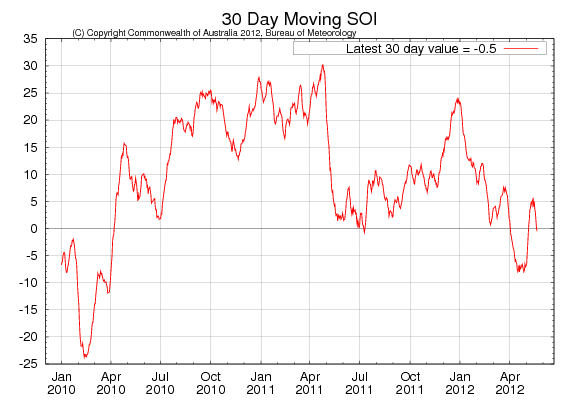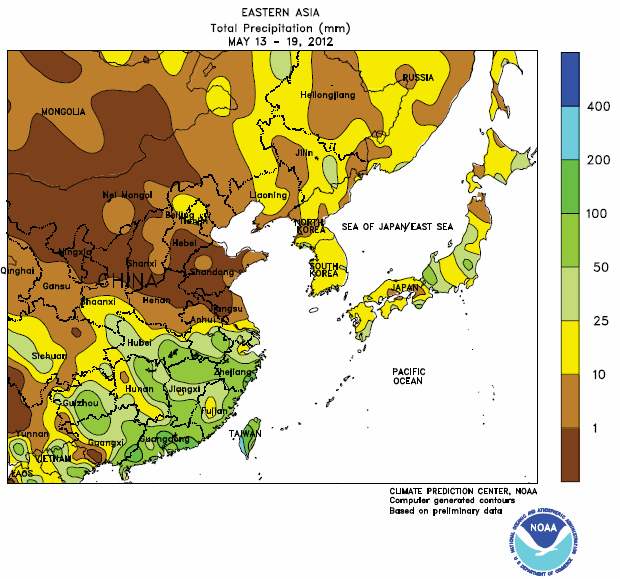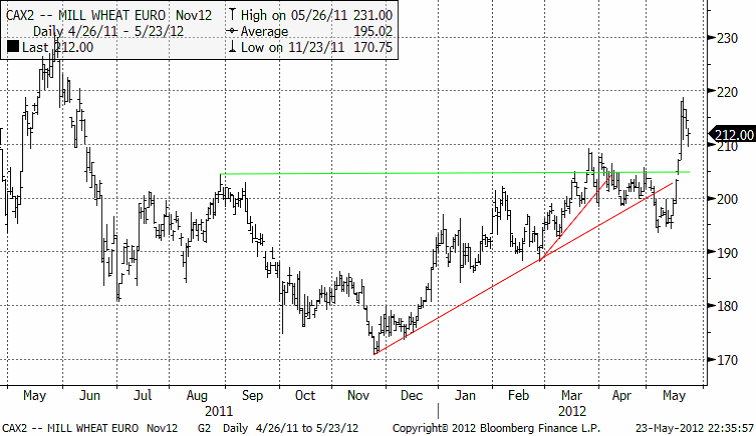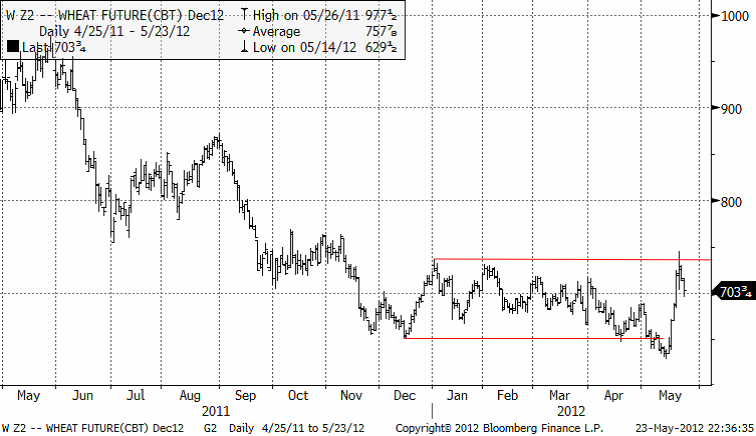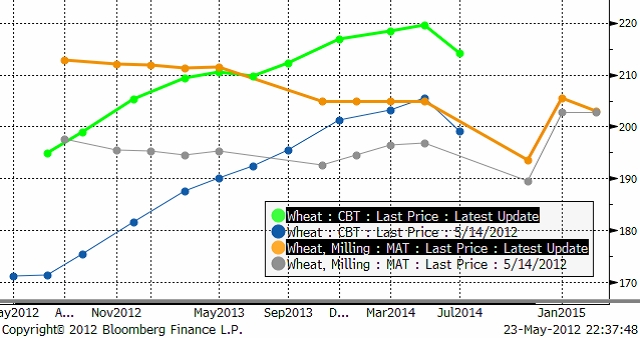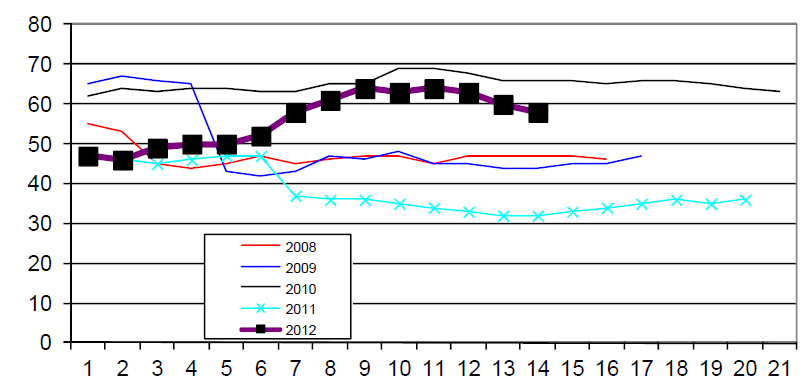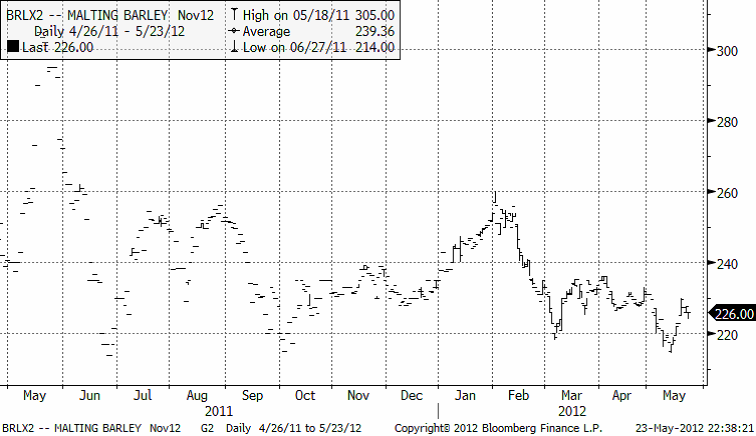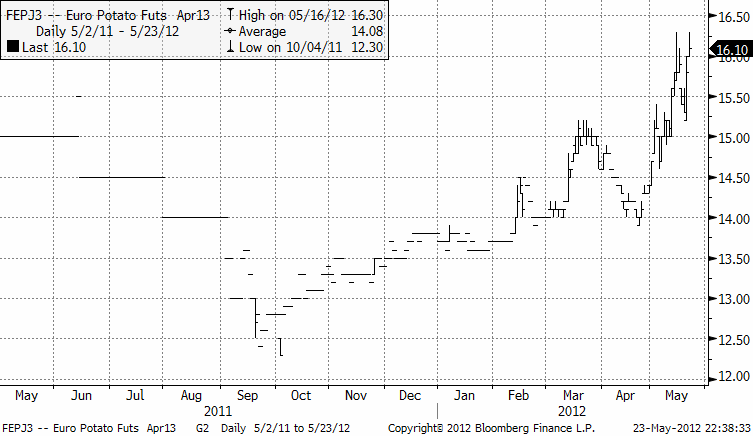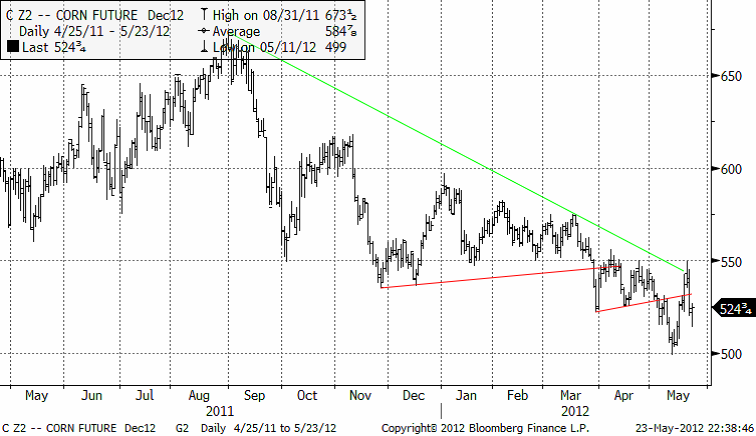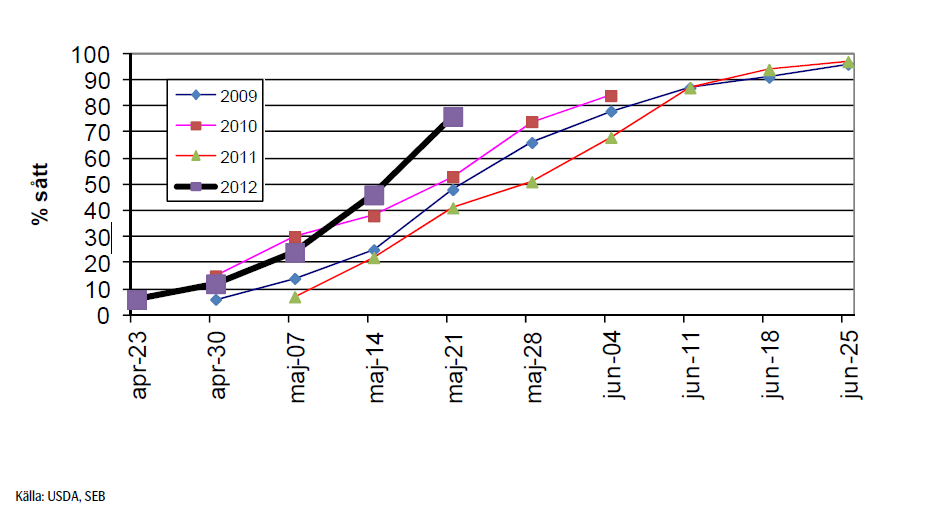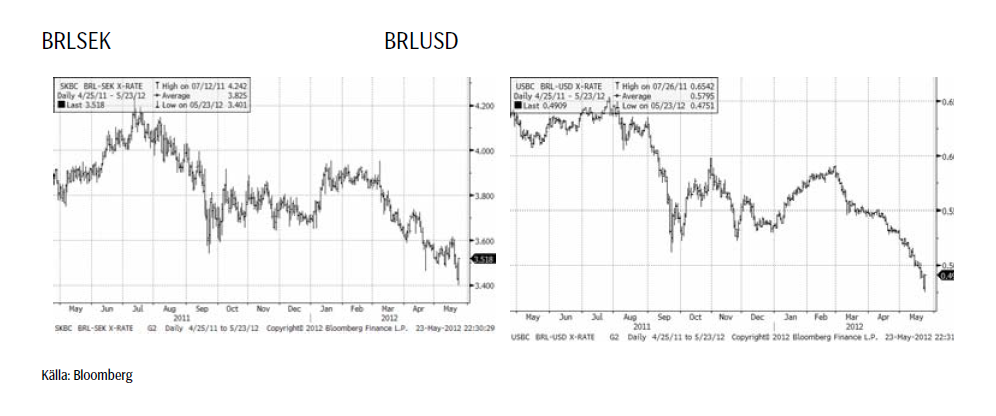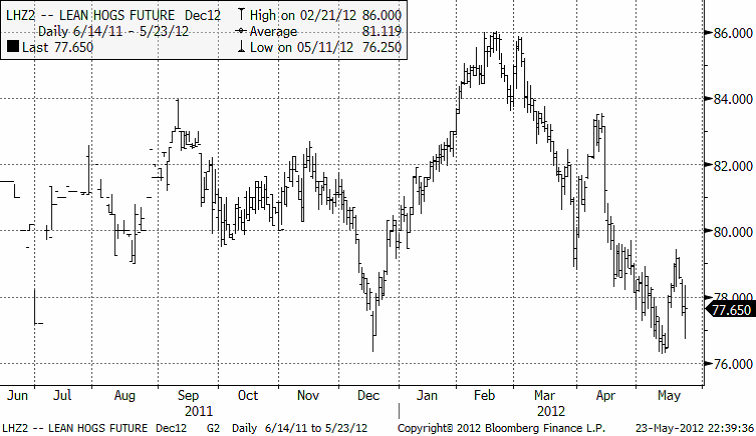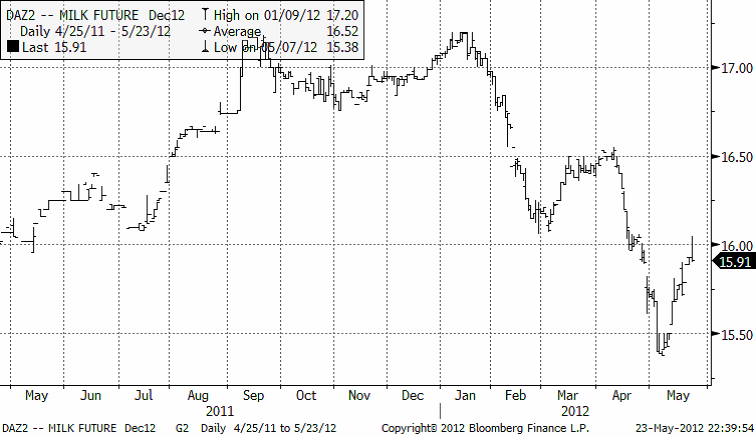Analys
SEB – Jordbruksprodukter, vecka 21 2012
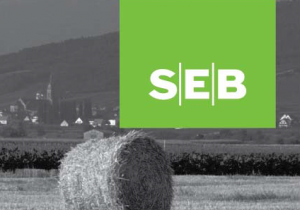 Greklands nyval den 17 juni med möjlig konsekvens att landet lämnar euron sänkte tillväxt- och eftefrågeförväntningarna igår onsdag med kraftiga prisfall på aktiemarknaderna runtom i världen och prisfall på de flesta råvaror. Detta har den senaste tiden påverkat framförallt priset på sojabönor negativt.
Greklands nyval den 17 juni med möjlig konsekvens att landet lämnar euron sänkte tillväxt- och eftefrågeförväntningarna igår onsdag med kraftiga prisfall på aktiemarknaderna runtom i världen och prisfall på de flesta råvaror. Detta har den senaste tiden påverkat framförallt priset på sojabönor negativt.
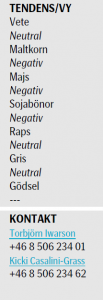 Ledande europeiska politiker motsäger varandra just nu om skuldkrisen. Merkel har sagt att hon inte är negativ till eurobonds, men säger samtidigt att det krävs en fördragsändring för detta, vilket är samma sak om att säga att det är omöjligt ändå. Viljan att på allvar lösa problemen tillsammans förefaller vara knäckt. Och det är den viljemässiga kapitulationen som öppnar för en tid av oro.
Ledande europeiska politiker motsäger varandra just nu om skuldkrisen. Merkel har sagt att hon inte är negativ till eurobonds, men säger samtidigt att det krävs en fördragsändring för detta, vilket är samma sak om att säga att det är omöjligt ändå. Viljan att på allvar lösa problemen tillsammans förefaller vara knäckt. Och det är den viljemässiga kapitulationen som öppnar för en tid av oro.
Hastigt uppblossande oro för torka drev upp priset framförallt på vete förra veckan, vid Kristi Himmelsfärdsdag. Det är torrt i Kina, torrt i Europa och torrt i USA. Nya väderleksprognoser som förutspår regn i USA om ca en vecka fick dock priset att falla tillbaka. Det regnar nu också i Europa, även om t ex Tyskland, utom de södra delarna blir utan regn den här gången. Vete, såväl Chicago som Matif är den klara vinnaren inom jordbruksproduktsmarknaderna den senaste veckan med prisuppgångar på 4% för ny skörd.
Odlingsväder
Southern Oscillation Index, ett mått på intensiteten i graden av La Niña eller El Niño, har fallit tillbaka. Australiensarna talar om möjligheten att ett El Niño inträffar i augusti.
Nedan ser vi förväntade förändringar i torkan i USA under sommaren. Vi ser att i de väsentliga delarna av USA väntas läget förbättras.
Går vi så över till läget i Europa, ser vi i bilden nedan att det har fallit ovanligt lite nederbörd den senaste tiden, framförallt gäller det Tyskland, Frankrike och Spanien.
Det talas också om torka i veteodlingsområdena i Kina och vi ser en bild på det nedan:
Kinas norra slättområden fick välbehövlig nederbörd i förrgår och igår.
Väderleksprognoserna ändrades i förrgår, för USA. Den nya prognosen visar betydligt mer nederbörd om 6-11 dagar i mellanvästern. Däremot ändrades inte prognosen för Europa, där det är torrare än normalt överallt utom vid Svarta Havet och på Balkan.
Vete
Matifvetet med novemberleverans steg med 10% på rapporterna om torka i Ryssland, Kina, Europa och USA förra veckan, men när nya prognoser innehållit regn har priset fallit tillbaka. Marknaden har såväl 2007/08 som 2010 i gott minne. Vid den här tiden på året är det torka som kan få priset att rusa uppåt rejält. Andra tider på året spelar torka betydligt mycket mindre roll. Egentligen borde risken avta, eftersom ENSO är neutral och effekten av La Niña borde klinga av.
Tekniskt kan vi dock konstatera att priset i och med den här kraftiga uppgången, har genererat en teknisk köpsignal. Motståndet på 210 har brutits och den nivån utgör nu istället ett stöd. Igår onsdag studsade priset också på just 210-nivån, där det fanns köpintressen, troligtvis en hel del som vill täcka korta positioner.
Nedan ser vi Chicagovetet med leverans i december. Här har det inte blivit någon teknisk köpsignal, eftersom prisuppgången stannade på motståndslinjen inritad i diagrammet.
Nedan ser vi hur terminspriserna på Matif och Chicago förändrats den senaste veckan. Terminskurvorna har gått mer in i backwardation (Matif) och mindre i contango (Chicago), samtidigt som den stora förändringen är ett parallellskift uppåt på båda kurvorna.
Crop condition för höstvetet i USA, som rapporterades i måndags kväll klockan 22, ligger på 58% good / excellent och det är 2% lägre än förra veckan. Crop condition har alltså fallit under 60% good/excellent.
Skörden av höstvete är nu redan klar i Louisiana, vilket är rekordtidigt. Skörden är väsentligt mindre än förväntat. Möjliga orsaker är den fuktiga vintern, att man gödslat mindre än normalt och att det varit ganska torrt och varmt på sistone. Många kommer nu att så en andra skörd av sojabönor, men oron finns att det är lite för torrt för att vara optimalt.
Argentinas bönder kommer att så noll hektar vete i höst i protest mot Kirchners politik att brandskatta lantbrukarna. I stället kommer man att så gräs. En stor del av den semibankrutta statens inkomster kommer från de drakoniska exportskatterna på uppåt 30%.
Den kommande veckan blir avgörande för trenden framöver. Kommer Matif och Chicagos priser att falla tillbaka i språren av mer nederbörd, eller kommer nya rapporter om torka att få priset att vända uppåt igen? Just nu är båda utfallen lika sannolika, dock att ENSO är neutral och alla tidigare torkkatastrofer orsakats av La Niña.
Maltkorn
Novemberkontraktet på maltkorn har inte påverkats värst mycket av torkoron på vetemarknaden.
Potatis
Potatispriset för leverans nästa år, har fortsatt att stiga. Det är en stark trend uppåt och det finns inga tecken på att den skulle avta. Vi väntar oss högre priser ännu.
Majs
Priset på decembermajs rekylerade återigen upp mot 550, men där fanns uppenbarligen gott om säljare. Trenden är klart nedåtriktad.
Sådden i USA är nu i princip avklarad, rekordtidigt.
Brasilianska bönder har sålt 84% av skörden redan. Samma tid förra året var det 65%. Man har även sålt 26% av 2013 års skörd. Förra året hade man ännu inte sålt något av denna. USDA förutspår en skörd om 78 mt 2013, men en survey genomförd i Sao Paulo av Reuters kom fram till 73.5 mt.
Den brasilianska realen fortsätter att falla. Nedan ser vi dels vad en real kostar i kronor och vad en real kostar i dollar.
Raps
Priset på novemberterminen befinner sig fortfarande i rekyl efter vårens kraftiga prisuppgång. Det är större brist på raps än på sojabönor och rapsen är mindre beroende av Kinas efterfrågan.
Gris
Decemberkontraket (och de kortare) tyngdes av högre lager enligt den senaste USDA-rapporten. Vi ser ändå att ”botten” tycks ha etablerats strax över 76 cent.
Mjölk
motstånd och det troliga är att kursen vänder nedåt igen.
[box]SEB Veckobrev Jordbruksprodukter är producerat av SEB Merchant Banking och publiceras i samarbete och med tillstånd på Råvarumarknaden.se[/box]
Disclaimer
The information in this document has been compiled by SEB Merchant Banking, a division within Skandinaviska Enskilda Banken AB (publ) (“SEB”).
Opinions contained in this report represent the bank’s present opinion only and are subject to change without notice. All information contained in this report has been compiled in good faith from sources believed to be reliable. However, no representation or warranty, expressed or implied, is made with respect to the completeness or accuracy of its contents and the information is not to be relied upon as authoritative. Anyone considering taking actions based upon the content of this document is urged to base his or her investment decisions upon such investigations as he or she deems necessary. This document is being provided as information only, and no specific actions are being solicited as a result of it; to the extent permitted by law, no liability whatsoever is accepted for any direct or consequential loss arising from use of this document or its contents.
About SEB
SEB is a public company incorporated in Stockholm, Sweden, with limited liability. It is a participant at major Nordic and other European Regulated Markets and Multilateral Trading Facilities (as well as some non-European equivalent markets) for trading in financial instruments, such as markets operated by NASDAQ OMX, NYSE Euronext, London Stock Exchange, Deutsche Börse, Swiss Exchanges, Turquoise and Chi-X. SEB is authorized and regulated by Finansinspektionen in Sweden; it is authorized and subject to limited regulation by the Financial Services Authority for the conduct of designated investment business in the UK, and is subject to the provisions of relevant regulators in all other jurisdictions where SEB conducts operations. SEB Merchant Banking. All rights reserved.
Analys
Tightening fundamentals – bullish inventories from DOE

The latest weekly report from the US DOE showed a substantial drawdown across key petroleum categories, adding more upside potential to the fundamental picture.

Commercial crude inventories (excl. SPR) fell by 5.8 million barrels, bringing total inventories down to 415.1 million barrels. Now sitting 11% below the five-year seasonal norm and placed in the lowest 2015-2022 range (see picture below).
Product inventories also tightened further last week. Gasoline inventories declined by 2.1 million barrels, with reductions seen in both finished gasoline and blending components. Current gasoline levels are about 3% below the five-year average for this time of year.
Among products, the most notable move came in diesel, where inventories dropped by almost 4.1 million barrels, deepening the deficit to around 20% below seasonal norms – continuing to underscore the persistent supply tightness in diesel markets.
The only area of inventory growth was in propane/propylene, which posted a significant 5.1-million-barrel build and now stands 9% above the five-year average.
Total commercial petroleum inventories (crude plus refined products) declined by 4.2 million barrels on the week, reinforcing the overall tightening of US crude and products.


Analys
Bombs to ”ceasefire” in hours – Brent below $70

A classic case of “buy the rumor, sell the news” played out in oil markets, as Brent crude has dropped sharply – down nearly USD 10 per barrel since yesterday evening – following Iran’s retaliatory strike on a U.S. air base in Qatar. The immediate reaction was: “That was it?” The strike followed a carefully calibrated, non-escalatory playbook, avoiding direct threats to energy infrastructure or disruption of shipping through the Strait of Hormuz – thus calming worst-case fears.

After Monday morning’s sharp spike to USD 81.4 per barrel, triggered by the U.S. bombing of Iranian nuclear facilities, oil prices drifted sideways in anticipation of a potential Iranian response. That response came with advance warning and caused limited physical damage. Early this morning, both the U.S. President and Iranian state media announced a ceasefire, effectively placing a lid on the immediate conflict risk – at least for now.
As a result, Brent crude has now fallen by a total of USD 12 from Monday’s peak, currently trading around USD 69 per barrel.
Looking beyond geopolitics, the market will now shift its focus to the upcoming OPEC+ meeting in early July. Saudi Arabia’s decision to increase output earlier this year – despite falling prices – has drawn renewed attention considering recent developments. Some suggest this was a response to U.S. pressure to offset potential Iranian supply losses.
However, consensus is that the move was driven more by internal OPEC+ dynamics. After years of curbing production to support prices, Riyadh had grown frustrated with quota-busting by several members (notably Kazakhstan). With Saudi Arabia cutting up to 2 million barrels per day – roughly 2% of global supply – returns were diminishing, and the risk of losing market share was rising. The production increase is widely seen as an effort to reassert leadership and restore discipline within the group.
That said, the FT recently stated that, the Saudis remain wary of past missteps. In 2018, Riyadh ramped up output at Trump’s request ahead of Iran sanctions, only to see prices collapse when the U.S. granted broad waivers – triggering oversupply. Officials have reportedly made it clear they don’t intend to repeat that mistake.
The recent visit by President Trump to Saudi Arabia, which included agreements on AI, defense, and nuclear cooperation, suggests a broader strategic alignment. This has fueled speculation about a quiet “pump-for-politics” deal behind recent production moves.
Looking ahead, oil prices have now retraced the entire rally sparked by the June 13 Israel–Iran escalation. This retreat provides more political and policy space for both the U.S. and Saudi Arabia. Specifically, it makes it easier for Riyadh to scale back its three recent production hikes of 411,000 barrels each, potentially returning to more moderate increases of 137,000 barrels for August and September.
In short: with no major loss of Iranian supply to the market, OPEC+ – led by Saudi Arabia – no longer needs to compensate for a disruption that hasn’t materialized, especially not to please the U.S. at the cost of its own market strategy. As the Saudis themselves have signaled, they are unlikely to repeat previous mistakes.
Conclusion: With Brent now in the high USD 60s, buying oil looks fundamentally justified. The geopolitical premium has deflated, but tensions between Israel and Iran remain unresolved – and the risk of missteps and renewed escalation still lingers. In fact, even this morning, reports have emerged of renewed missile fire despite the declared “truce.” The path forward may be calmer – but it is far from stable.
Analys
A muted price reaction. Market looks relaxed, but it is still on edge waiting for what Iran will do

Brent crossed the 80-line this morning but quickly fell back assigning limited probability for Iran choosing to close the Strait of Hormuz. Brent traded in a range of USD 70.56 – 79.04/b last week as the market fluctuated between ”Iran wants a deal” and ”US is about to attack Iran”. At the end of the week though, Donald Trump managed to convince markets (and probably also Iran) that he would make a decision within two weeks. I.e. no imminent attack. Previously when when he has talked about ”making a decision within two weeks” he has often ended up doing nothing in the end. The oil market relaxed as a result and the week ended at USD 77.01/b which is just USD 6/b above the year to date average of USD 71/b.

Brent jumped to USD 81.4/b this morning, the highest since mid-January, but then quickly fell back to a current price of USD 78.2/b which is only up 1.5% versus the close on Friday. As such the market is pricing a fairly low probability that Iran will actually close the Strait of Hormuz. Probably because it will hurt Iranian oil exports as well as the global oil market.
It was however all smoke and mirrors. Deception. The US attacked Iran on Saturday. The attack involved 125 warplanes, submarines and surface warships and 14 bunker buster bombs were dropped on Iranian nuclear sites including Fordow, Natanz and Isfahan. In response the Iranian Parliament voted in support of closing the Strait of Hormuz where some 17 mb of crude and products is transported to the global market every day plus significant volumes of LNG. This is however merely an advise to the Supreme leader Ayatollah Ali Khamenei and the Supreme National Security Council which sits with the final and actual decision.
No supply of oil is lost yet. It is about the risk of Iran closing the Strait of Hormuz or not. So far not a single drop of oil supply has been lost to the global market. The price at the moment is all about the assessed risk of loss of supply. Will Iran choose to choke of the Strait of Hormuz or not? That is the big question. It would be painful for US consumers, for Donald Trump’s voter base, for the global economy but also for Iran and its population which relies on oil exports and income from selling oil out of that Strait as well. As such it is not a no-brainer choice for Iran to close the Strait for oil exports. And looking at the il price this morning it is clear that the oil market doesn’t assign a very high probability of it happening. It is however probably well within the capability of Iran to close the Strait off with rockets, mines, air-drones and possibly sea-drones. Just look at how Ukraine has been able to control and damage the Russian Black Sea fleet.
What to do about the highly enriched uranium which has gone missing? While the US and Israel can celebrate their destruction of Iranian nuclear facilities they are also scratching their heads over what to do with the lost Iranian nuclear material. Iran had 408 kg of highly enriched uranium (IAEA). Almost weapons grade. Enough for some 10 nuclear warheads. It seems to have been transported out of Fordow before the attack this weekend.
The market is still on edge. USD 80-something/b seems sensible while we wait. The oil market reaction to this weekend’s events is very muted so far. The market is still on edge awaiting what Iran will do. Because Iran will do something. But what and when? An oil price of 80-something seems like a sensible level until something do happen.
-

 Nyheter3 veckor sedan
Nyheter3 veckor sedanStor uppsida i Lappland Guldprospekterings aktie enligt analys
-
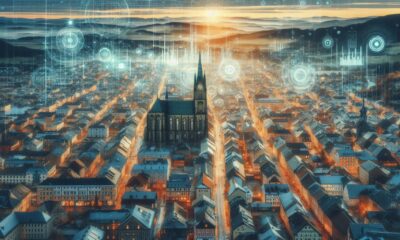
 Nyheter4 veckor sedan
Nyheter4 veckor sedanBrookfield ska bygga ett AI-datacenter på hela 750 MW i Strängnäs
-

 Nyheter3 veckor sedan
Nyheter3 veckor sedanSilverpriset släpar efter guldets utveckling, har mer uppsida
-

 Nyheter4 veckor sedan
Nyheter4 veckor sedanTradingfirman XTX Markets bygger datacenter i finska Kajana för 1 miljard euro
-

 Nyheter2 veckor sedan
Nyheter2 veckor sedanUppgången i oljepriset planade ut under helgen
-

 Nyheter2 veckor sedan
Nyheter2 veckor sedanLåga elpriser i sommar – men mellersta Sverige får en ökning
-

 Analys2 veckor sedan
Analys2 veckor sedanVery relaxed at USD 75/b. Risk barometer will likely fluctuate to higher levels with Brent into the 80ies or higher coming 2-3 weeks
-

 Nyheter1 vecka sedan
Nyheter1 vecka sedanMahvie Minerals växlar spår – satsar fullt ut på guld


